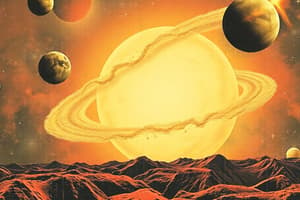Podcast
Questions and Answers
What does Hubble's Law state?
What does Hubble's Law state?
The law states that the velocity of a galaxy is proportional to its distance from us.
What does Hubble's Law mean?
What does Hubble's Law mean?
A law of cosmology stating that the rate at which astronomical objects in the universe move apart from each other is proportional to their distance from each other.
How do you determine the velocity of a galaxy?
How do you determine the velocity of a galaxy?
Doppler shift
Describe the technique used to determine the distance of the galaxies used in the lab.
Describe the technique used to determine the distance of the galaxies used in the lab.
What was the greatest source of error in this lab?
What was the greatest source of error in this lab?
How old is the Universe?
How old is the Universe?
Why use a line of best fit?
Why use a line of best fit?
Flashcards are hidden until you start studying
Study Notes
Hubble's Law Overview
- Hubble's Law states that a galaxy's velocity is directly proportional to its distance from Earth.
- It indicates that astronomical objects are moving apart in the universe at a rate dependent on their distances.
Understanding Hubble's Law
- A fundamental principle in cosmology explaining the expansion of the universe.
- Suggests that the farther away an object is, the faster it appears to be receding from us.
Measuring Galaxy Velocity
- The velocity of a galaxy can be determined through the Doppler shift, which measures changes in the wavelength of light due to motion.
Distance Measurement Technique
- Measure the longest diameter of galaxies in black and white images using a ruler, ensuring to include faint outer edges.
- Record measurements in millimeters and convert them to megaparsecs (Mpc) using graphical data for accuracy.
Sources of Error in Measurements
- The main source of error arises from inaccurately determining the starting and ending points of galaxies.
Age of the Universe
- The universe is estimated to be approximately 13.8 billion years old.
Importance of Line of Best Fit
- The line of best fit is used to calculate the Hubble constant, represented by the slope (rise/run), measured in km/sec/Mpc.
Studying That Suits You
Use AI to generate personalized quizzes and flashcards to suit your learning preferences.



